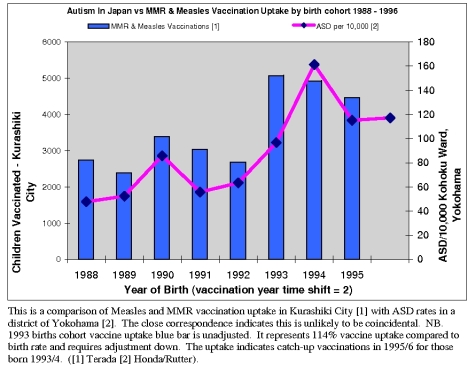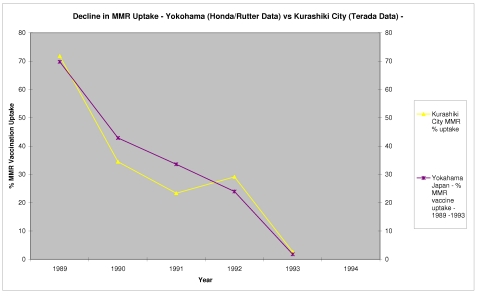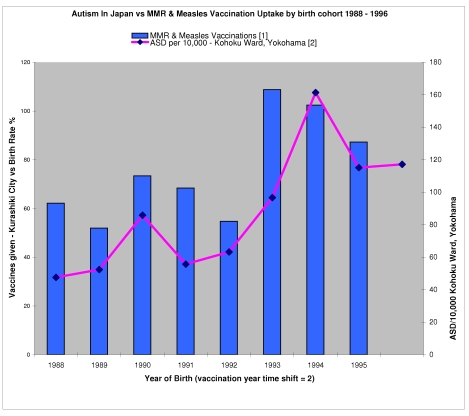Japanese & British Data Show Vaccines Cause Autism
Posted on June 3, 2009 by
childhealthsafety
Just months following the US Court of Federal Claims rejection of the claim that the MMR vaccine causes autism, here you will see data from formal peer refereed medical papers showing that vaccines caused autism in British and in Japanese children and will be doing the same to children around the world. The number of Japanese children developing autism rose and fell in direct proportion to the number of children vaccinated each year:-
[click image for larger graph in new window]
Click here on Contents for full details of the Japanese data [after our short section below on "British Data Show Vaccines Cause Autism"].
[See end of page for the above graph by annual % of children receiving MMR vaccination - still showing the same correspondence.]
I – British Data Show Vaccines Cause Autism
Information from formal peer reviewed papers including data from the UK’s General Practice Research Database shows that with each major change in the UK childhood vaccination programme the rates of childhood autism have increased significantly.
[Click on graph to enlarge in new window]
[Article updated 27 April 2010 to include British data]
The graph above is adapted from a 2001 paper by Jick et al. The authors claimed [emphasis added]:-
“... the data provide evidence that no correlation exists between the prevalence of MMR vaccination and the rapid increase in the risk of autism over time. The explanation for the marked increase in risk of the diagnosis of autism in the past decade remains uncertain. ….. The increase ….. could be due to …… environmental factors not yet identified.”
“Mumps, measles, and rubella vaccine and the incidence of autism recorded by general practitioners: a time trend analysis” BMJ 2001;322:460-463 24 February.
The data shows something different and when correlated with major changes in the UK childhood vaccination programme shows what are the most likely “environmental factors not yet identified“. With each major change to the UK’s childhood vaccination programme cases of childhood autism increased substantially.
The childhood autism risk increased three-fold for children born in 1988 and 1989 from the previous rate of between 1 and 4 in 10,000 to 12 in 10,000.
The major change: the MMR vaccine was introduced in October 1988. Routine administration was at around 15 months.
The childhood autism risk increased five-fold for children born in 1990 and 1991 to 20 in 10,000 from the pre 1988 rate of 1 to 4 in 10,000.
The major change: in May 1990 the accelerated DTP vaccine programme was introduced. British babies were given the DTP vaccine substantially earlier at 2, 3 and 4 months instead of the previous 3, 5 and 10 months: [Persistence of antibody after accelerated immunisation with diphtheria/tetanus/pertussis vaccine: 1489 BMJ VOLUME 302 22 JUNE 1991]
The childhood autism risk increased nearly eight-fold for children born in 1993 to 29 in 10,000 from the pre 1988 rate of 1 to 4 in 10,000.
The major change: the Haemophilus Influenzae b vaccine was introduced in October 1992. Routine administration was three doses at 2, 3 and 4 months. [Routine Hib Vaccine: 438 BMJ VOLUME 305 22 AUGUST 1992, Hib immunisation catch up programme in North East Thames: R17 Communicable Disease Report Vol 4 Review Number 2 4 February 1994]
It appears it was only from 1993 that most infants were vaccinated
at 2, 3 and 4 months with those born earlier being vaccinated at later ages
in “catch-up campaigns”. This data suggests that to reduce the risk of
autism from vaccines parents should delay the age at which their children
are vaccinated.
One study shows that average vaccine coverage by November 1993 was 34% for 1989 births, 77% for 1990 births, 87% for 1991 births, and 89% for 1992 births: [“Haemophilus influenzae: the efficiency of reporting invasive disease in England and Wales” Communicable Disease Report R13 4:2 4 February 1994].
The current UK rate of children with autistic conditions is 1 in 64 [or 157 per 10,000 children]: “Prevalence of autism-spectrum conditions: UK school-based population study” Baron-Cohen S, Scott FJ, Allison C, Williams J, Bolton P, Matthews FE and Brayne C (2009) British Journal of Psychiatry, 194: 500-509.
The rate in boys is 1 in 40. Prior to 1988 which saw the first of several major changes to the UK childhood vaccination programmes the rate of childhood autism was running at between 1 and 4 in 10,000. Childhood autism is also known as “typical” or “Kanner” autism.
In addition to vaccines being a biologically plausible cause of the worldwide increases in autistic conditions in children we have also seen legal cases in the USA confirming vaccines have caused autism in US children: AUTISM – US Court Decisions and Other Recent Developments – It’s Not Just MMR
The data presented here provides further evidence of the unscientific approach of medical researchers when publishing papers purporting to support the claim there is no association between vaccines and autism.
[Further details in our related article: British Data Show Vaccines Cause Autism]]
II – Japanese Data Show Vaccines Cause Autism
Contents
Introduction & Peer Reviewbr />
FFlawed “Science” By Doctors Not Scientists
The Invalid Claims of Honda and Rutter
The Vaccination Data Honda/Rutter Omitted
Japanese Autism Numbers Rose & Fell With Vaccinations
Professor Sir Michael Rutter & The Drug Industry Connections
Introduction & Peer Review
The “science” from medical journals presented to courts is not reliable. The medical “science” evidence-base has become institutionally and systemically corrupt since US President Ronald Reagan introduced the Bayh-Dole Act in the 1980′s : ["Doctors Without Borders - Why you can't trust medical journals anymore" by Shannon Brownlee, Washington Monthly].
Mainstream medical journals live off drug company advertising. Government health officials, drug company lobbyists and medical professionals tell us: it is “science” and “proof” when it is not.
Covert lobbying is endemic:-
‘The use of PR to counter negative publicity’
’221. ………. Considerable resources are invested into building long-term, sustainable relationships with stakeholders and ‘key opinion leaders‘ and journalists. These relationships are used to promote the use of certain brands and counter concerns relating to safety. Efforts to undermine critical voices in particular were identified, under terms of “issues management”. In later evidence, in response to the ISM’s memorandum, Pfizer stated that PR is entirely legitimate and can “help to educate and inform”. According to the PMCPA, PR activities may include “placing articles in the lay press, TV documentaries, soap operas etc“.’ [p60 'The Influence of the Pharmaceutical industry' 2004 - English Parliamentary Health Select Committee report [emphasis added]]
Court evidence now available on-line at the University of California library shows drug giant Merck systematically targeted “hit-lists” of doctors to discredit, neutralize or destroy critics of the safety and effectiveness of Merck’s drugs, : Drug Giant Merck – “Destroy” Critical Doctors “Where They Live”. Other examples include Merck paying medical journal publisher company Elsevier [whose CEO Sir Crispin Davis sits on GlaxoSmithKline's board] to publish a fake medical journal with articles favorable to Merck’s drugs: [Merck published fake journal - Bob Grant - The Scientist - 30th April 2009]. Drug maker Wyeth flooded medical journals with some 40 ghostwritten articles penned by prominent physicians who sold their name for cash, in an all-out effort to offset the scientific evidence linking its female hormone replacement drug, Prempro, to breast cancer: [Judge orders Wyeth papers unsealed – Associated Press – July 25, 2009].
The US Justice Department publicized a US$650 million fraud settlement agreed to by pharmaceutical giant Merck for a fraud on patients and the US government healthcare system involving a conspiracy with US hospitals to give the elderly cheaper drugs but charging them for the more expensive product prescribed by the patients’ doctors. More Fraud By Drug Giant Merck – US$650 Million,
And governments expect the public to trust the health and safety of their children to products from companies like that.
Peer Review of Data
The data and analysis shown here has been through a process of peer
review. Publication is responsible to bring it to public attention.
The peer review process included presenting this information to:-
- Professor Sir Michael Rutter, author of the main paper which this analysis critiques. Result: – no comment, rebuttal or answer [although correspondence sent was received] – Main paper “No effect of MMR withdrawal on the incidence of autism: a total population study..” Journal of Child Psychology and Psychiatry (2005)]
- Hideo Honda correspondent author of the main paper. Result – no comment, rebuttal or answer [correspondence twice sent to address for correspondence on the paper];
- Professor Tony Charman, Editor of the publishing journal. Result::- refusal to comment, rebut, answer or publish a correction or retraction [although correspondence sent was received];
- UK’s Joint Committee on Vaccination and Immunisation, Chairman Professor Andy Hall. Result:: no comment, rebuttal or answer [although correspondence sent was received];
- Head of UK Health Protection Agency. Result:: no comment rebuttal or answer [although correspondence sent was received];
- the publishers Blackwell Publishing. Result: no comment, rebuttal or answer [although correspondence sent was received].
IIt has also been presented to others including an expert in the assessment of adverse drug reactions who confirmed data showing such a close correspondence is remarkable in post marketing surveillance and rarely if ever seen – probably unique.
Flawed “Science” By Doctors Not Scientists
In 2005 a paper by two Japanese psychiatrists, Hideo Honda and Yasuo Shimizu, was published in an English psychiatric journal with English psychiatrist Professor Sir Michael Rutter also named as an author. The paper was claimed to be proof MMR vaccine could not cause autistic spectrum disorders: [“No effect of MMR withdrawal on the incidence of autism: a total population study.” Journal of Child Psychology and Psychiatry (2005)].
The scientific reality is that the only thing Honda/Rutter teaches us is that MMR vaccine cannot be the only vaccine to cause autistic spectrum disorders – and not that it is not a cause of autism.
These three psychiatrists failed to provide the full picture.
They made invalid claims [See more below
The Invalid Claims]. Those claims were based on inadequate
research containing basic flaws. Psychiatrists are not usually
also trained scientists and normally lack scientific qualifications. When
the flaws in their paper are identified and corrected, the paper provides
unusually strong evidence, not normally seen, showing vaccines as a cause of
Autistic Spectrum Disorders (ASD).
The paper shows, when corrected with the missing data, Autistic Spectrum Disorder numbers increased and decreased in direct proportion to the total number of children vaccinated. WWe see here not just evidence of dechallenges and rechallenges but a “dose-response” relationship on a population level.
A dose-response relationship on a population level is rare if not unprecedented. The close numerical correspondence seen here is usually not found. This is conclusive evidence of a causal association.
The Honda/Rutter paper claimed that new cases of autism in Japan fell for children born in 1991-92 (as the confidence of Japanese parents fell in the dangerous Japanese MMR vaccine withdrawn on safety grounds in 1992) but then rose sharply again and especially for children who were born in 1993-94. Here is the graph from the Honda/Rutter paper:-
[a href="http://childhealthsafety.files.wordpress.com/2009/01/honda2.jpg" target="_blank" larger graph in new window]
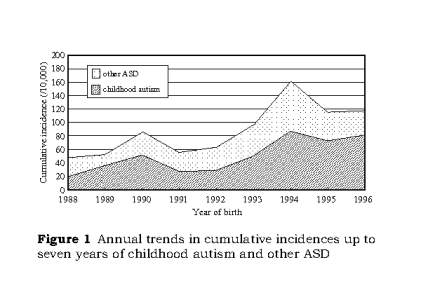
The authors summarized their results (emphasis added):-
The MMR vaccination rate in the city of Yokohama declined significantly in the birth cohorts of years 1988 through 1992, and not a single vaccination was administered in 1993 or thereafter. In contrast, cumulative incidence of ASD up to age seven increased significantly in the birth cohorts of years 1988 through 1996 and most notably rose dramatically beginning with the birth cohort of 1993.”
The authors wrongly claimed this meant it was unlikely MMR
vaccine caused autism spectrum disorders. They made this claim without
any “control” – a scientific fundamental – something to compare against
MMR – a scientific benchmark or yardstick to see if there was any
difference compared with something else.
AAs can be seen from the above Honda/Rutter graph, in 93-94 and after, the autism rate was double that in the period up to 1992 [when the MMR vaccine was withdrawn]. The authors were duty bound to consider this before going into print. Their data put them on notice that withdrawing the proven dangerous Japanese MMR vaccine was associated with a marked drop in new cases of autism. That is clear from their graphs. Autism cases fell for those born in 1991-92 as uptake of the Japanese MMR vaccine fell and was withdrawn in 1992.
The authors failed to do what any scientist would have done. They failed to ask themselves “why?“. Why did autism rapidly increase for children born in 1993-94 and thereafter?
AAnd there was something to compare against the MMR. Honda/Rutter did not use it.
The MMR was replaced with single measles and single rubella vaccines. These were given at or about at the same time. And also span style="TEXT-DECORATION: underline">at the same time the overall vaccination rate in Japan was increased by 150%.
When this happened the autism rate increased in step.
Professor Rutter has close associations with the drug industry including GlaxoSmithKline. He was a paid expert witness on their behalf in the UK MMR vaccine damage litigation. That was not declared in the Honda/Rutter paper nor were any other potential conflicts of interest or statements of funding (about which see more below).
Professor Rutter is also one of the main prosecution witnesses in the witchhunt in the British General Medical Council against medical doctors Andrew Wakefield, Simon Murch and Professor Walker-Smith.
The Invalid Claims
The Honda/Rutter paper when corrected provides not only strong evidence that MMR and single measles vaccines are causes of ASD but it also implicates as causes of ASD the rubella vaccine and JE (Japanese Encephalitis) vaccine containing Thiomersal [Thimerosal in the USA]. Thiomersal is a known toxic mercury containing neurotoxin and also causes allergies. It is toxic in parts per billion.
Japanese Encephalitis vaccine was given in three separate vaccinations and each one contained the poisonous mercury based neurotoxin thiomersal. So JE vaccine is just like DTP given to children in the USA and UK up until very recently in that it contained that neurotoxin and was given in three jabs to infants or toddlers.
That the practice in Japan was to give the measles and rubella vaccines at the same time was the boast of The British Department of Health. That was to bolster official claims that whistle blower medical doctor Andrew Wakefield’s concerns about the MMR vaccine were wrong. The Honda/Rutter paper was announced in the usual blaze of publicity. And as usual, the truth has not been. No one can argue validly that scientifically the Honda/Rutter paper is not deeply flawed.
In Japan when MMR was introduced, single measles vaccine was still being used side-by-side with MMR. Professor Rutter and his colleagues failed to take that into account. They also failed to look to two peer refereed papers published only three years earlier in 2002 which provide some of the missing data:-
- the “Nakatani paper” after the lead author, Hiroki Nakatani: Development of Vaccination Policy in Japan: Current Issues and Policy Directions, Hiroki Nakatani,Tadashi Sanoand Tsutomu Iuchi Jpn J Infect Dis 55 101-111 2002.
- the “Terada paper“, after the lead author Kihei Terada: Alterations in epidemics and vaccination for measles during a 20 year period and a strategy for elimination in Kurashiki City, Japan: Terada K, Niizuma T, Ogita S, Kataoka N. Kansenshogaku Zasshi: Department of Pediatrics, Kawasaki Medical School 2002 Mar;76(3):180-4
The Nakatani and
Terada papers provide a more complete picture. The
Terada paper sets out the annual Japanese vaccination data for the
annual numbers of vaccinations for measles and MMR vaccines combined
in Kurashiki City, Japan. The
Nakatani paper sets out the overall national Japanese vaccination data
for all regions including Yokohama. Its data includes vaccine uptake
in Japan for measles, rubella and the mercury containing Japanese
Encephalitis vaccine.
In addition Honda/Rutter missed another Japanese paper from 2003 – Takahashi – claiming the risk of autism could be between 5 and 9 times greater from single measles and rubella vaccines, so Honda/Rutter have no excuses for not considering this possibility and including the single vaccines as a control or comparison group:
- An Epidemiological Study on Japanese Autism concerning Routine Childhood Immunization History – Hiroshi Takahashi*, Syunsuke Suzumura, Fumiko Shirakizawa, Noriyuki Wada, Keiko Tanaka-Taya, Satoru Arai, Nobuhiko Okabe, Hironobu Ichikawa and Taizo Sato
Jpn. J. Infect. Dis., 56, 114-117, 2003
The Takahashi paper is further direct evidence of
a link between vaccines and autism – despite repeated
denials by health officials, “expert” panels, medical professionals and
journalists that there is no evidence of such a causal link. The
confidence intervals for the Takahashi data are large which brings the
results of the study into doubt and the authors called for a nationwide
study. However, its existence and conclusions would have put the
Honda/Rutter paper’s authors on notice that they needed also to consider the
causal association with single vaccines. This is in addition to it
being well-known and accepted since at least 1966 that rubella virus is a
cause of autism. Thus making it biologically plausible for a vaccine
virus and particularly one containing rubella virus to cause autism.
A study post dating Honda/Rutter compared Japanese children who received the MMR vaccine with “unvaccinated” Japanese children and found no difference in regressive autism rates: MMR-Vaccine and Regression in Autism Spectrum Disorders: Tokio Uchiyama, Michiko Kurosawa, Yutaka Inaba J Autism Dev Disord (2007) 37:210–217.
However, the “unvaccinated” children were not. These were children who had received the single measles and rubella vaccines. So that study also goes to support the findings presented here that it is the vaccines and/or the combinations of vaccines which are causally associated with autistic conditions.br />
Grateful thanks for generously making his library facilities available pro bono publico without condition or hesitation, and especially so for enabling the key Terada paper to be located are due to Professor Jeff Bradstreet MD, MD(H) FAAFP, Adjunct Professor of Pediatrics, Southwest College of Naturopathic Medicine, International Child Development Research Centre, Melbourne, FL 32934, USA. It is certain some children and their families could be saved from a lifetime of autism if the information here becomes more widely available to parents, independently minded physicians and other medical practitioners.
Japanese Autism Numbers Rose & Fell With Vaccinations
When Honda/Rutter is compared to Terada it can be seen that ASD numbers rose and fell in direct proportion to the total number of children vaccinated in any year. In other words, the number of Japanese children who developed autism was directly related to the number who received MMR, single measles, rubella and Japanese Encephalitis vaccines. Here is a combined graph showing this:-
This is a dose-response relationship – the extent of the effect of a drug is related to the amount of the drug administered. Unusually, we see a dose-response relationship on a “population level” in a large sample of the child population of Japan, and as such, this is conclusive evidence of a causal association between vaccination and Autistic Spectrum Disorders in children.
Immediately below is the data from the Terada and Honda/Rutter papers shown separately in the graphs, from the original papers as published:-
[larger Terada graph in new window]
[larger Honda/Rutter graph in new window]/big>
| Terada Paper: Fig. 4 Numbers of measles vaccinations and births in Kurashiki City from 1980 to 2000 | |
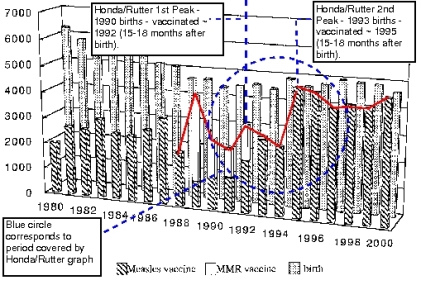 |
|
|
Red Line joins tops of
bars. It shows the total of MMR and Measles vaccinations each
year in Kurashiki City from 1980 to 2000.
|
|
| Honda/Rutter Fig. 1: Numbers of ASD diagnoses in children up to 7 years of age by year of birth | |
 |
|
These graphs compare data for children born in two different areas: Kurashiki City with Kohoku Ward, Yokohama. The correspondence is remarkable. [Note when comparing the first graph, Japanese children were vaccinated when 15-18 months old - so the comparison of ASD rates by year of birth is with the vaccination rates approximately two years later. The first graph is 15-18 months “ahead” of the second.]
Further, the Nakatani paper indicates this similarity in the data is unlikely to be coincidence: [Development of Vaccination Policy in Japan: Current Issues and Policy Directions, Hiroki Nakatani,Tadashi Sanoand Tsutomu Iuchi Jpn J Infect Dis 55 101-111 2002]. The Nakatani paper shows the national vaccination rates in Japan. These are closely similar in profile to that shown for Kurashiki City. It is also reasonable to expect that the national vaccination rates would be similar for Kohoku Ward (data in the Honda/Rutter paper).
It is the Nakatani paper which implicates rubella vaccine and the thiomersal/thimerosal mercury containing JE (Japanese Encephalitis) vaccines along with MMR and Japanese Encephalitis vaccine. The Nakatani paper shows that in 1995 there was a sharp rise (150%) in single measles and single rubella vaccinations. Many of the children getting those vaccines in 1995 would have been those born in 1993-4. This rise was also coupled with a doubling in Japanese Encephalitis vaccinations (200%) between 1993 and 1995.
Here is the graph from the Nakatani paper showing the increases in single measles, rubella and JE vaccine vaccination rates by 1995 in Japan – the vertical blue line has been added to highlight the year and the legend ringed in blue to pick out the measles, rubella and JE vaccine lines of the graph:-
[a href="http://childhealthsafety.files.wordpress.com/2009/01/japvaccrise.jpg" target="_blank">llarger Nakatani graph in new window]
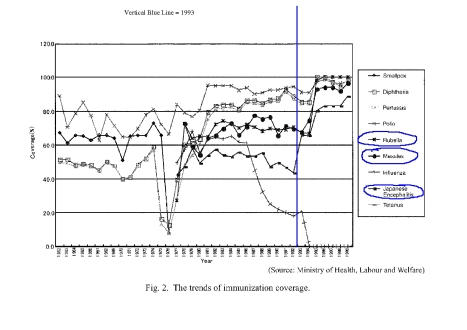
And after the 150% increase in measles and rubella vaccinations and the doubling in the JE vaccine uptake, the graph shows that autism incidence doubled.
Incidence rose from 60 in 10,000 (1991-92 births) to 120 in 10,000 (1995-96 births). The same applies to the peaks in the graph in 1990 and 1994. The 1990 peak was 80 in 10,000 and the 1994 peak was double that at 160 in 10,000.
Grateful thanks to to Dr F E Yazbak of Boston Massachusetts, USA for drawing attention to the Nakatani paper and so assisting to identify this population level rechallenge proof of autism causation of the MMR and mercury containing vaccines.
This shows that not only did the authors of the Honda/Rutter paper have before them evidence of a “population level” dechallenge, they also had evidence of a “population level” rechallenge. Had they carried out their researches properly, they would also have had the evidence of the Nakatani and Terada papers to show the powerful evidence of a dose-response relationship on a population level.
How Comparable Are These Two Cities?
The graph below demonstrates how comparable Kurashiki City and Yokohama are for MMR vaccination uptake. This is in addition to the national figures for Japan from the Nakatani paper which apply to both cities. The Nakatani figures show [for the second autism peak in the Honda/Rutter paper for children born in 1994] there was 150% increase in single vaccine uptake throughout Japan and a 200% increase for Thiomersal containing Japanese Encephalitis vaccine. [These increases followed the change in the national Japanese vaccination law in 1994. Children born that year would have been vaccinated 15-18 months later with MMR and 12-24 months later with JE vaccine].
[Click graph for larger version in new window].
Just one well documented spontaneous report of a rechallenge is sufficient to prove a drug causes a harmful adverse drug reaction. Only three well documented cases of dechallenge are sufficient proof.
But here we see these numerous dechallenges and rechallenges combining into a continuous dose-response relationship on a population level. This is unusual and powerful proof of a causal association.
“Dechallenge” is the withdrawal of the administration of a drug from a person after they have been taking it. If adverse symptoms suffered by the person diminish with withdrawal of the drug, that is evidence the reaction is caused by the drug. “Rechallenge” is where the same drug is reintroduced and the adverse reactions start again. This is standard well-known and well-accepted pharmacological science. “Spontaneous” means you do not have to carry out a drug trial. If it happens to an ordinary patient at any time anywhere but is well documented, that can be sufficient proof.
Here, we see the Honda/Rutter paper in conjunction with the Nakatani paper providing us with a large number of examples of dechallenges and rechallenges. This is not in a few individuals but in large samples of the child population of Japan. And the dechallenges and rechallenges are well documented in published peer refereed papers.
The Terada paper also shows us that in this sample Japanese population (hence the term “population level”) the dechallenges and rechallenges combine to show us a population level dose-response relationship. That means we see the adverse effects increasing and decreasing in proportion to the quantity of the pharmaceutical (here vaccines) administered to the sample population. That is powerful as proof of a causal association between the vaccines and autistic spectrum disorders. You can read further about the power of dechallenge and rechallenge evidence in this peer refereed medico-legal paper by Professor Donald Miller MD, professor of surgery at the University of Washington and published in the Journal of American Physicians and Surgeons:-
The Honda/Rutter graph shows that autism incidence was rising over the entire period from 1988 to 1996. Thus this is more evidence to confirm the world autism pandemic, and which is other evidence the Honda/Rutter authors had before them which they did not deal with.
Professor Sir Michael Rutter & The Drug Industry Connections
It is appropriate to ask:
- “who is Professor Sir Michael Rutter?”
- “might he at least subconsciously suffer from author bias?“
- “does he have any potentially conflicting interests?”
It can help to follow the money. In the money connections, you don’t get any bigger than Rutter. Psychiatrist Professor Sir Michael Rutter is a former (recent) Deputy Chairman of the immensely wealthy Wellcome Trust (founded by the Wellcome Foundation which is now Glaxo). For confirmation of his status, see the 4th page of :-
The Wellcome Trust has assets of over £14 billion:-
The Trust hands out millions every year and has far more substantial reserves to enable it to do that. And it can dictate a great deal of what research is carried out around the world. See here for details:-
So Rutter is very influential. You do not get to be in that position if you are not “in favour with pharma”. He is also one of the expert witnesses for Glaxo in the MMR litigation (something he did not declare, for example, in the Honda/Rutter paper denying MMR has any association with autism, but I do not see him before the GMC over that). Professor Rutter is also one of the main prosecution witnesses in the witchhunt in the British General Medical Council against medical doctors Andrew Wakefield, Simon Murch and Professor Walker-Smith. Here is a biographical note on Professor Sir Michael Rutter from the Academy of Medical Sciences which says:-
Professor Sir Michael Rutter is Professor of Developmental Psychopathology at the Institute of Psychiatry, Kings College, London. He has been a consultant psychiatrist at the Maudsley Hospital since 1966, and was Professor of Child Psychiatry at the Institute of Psychiatry from 1973 to 1998. He set up the Medical Research Council Child Psychiatry Research Unit in 1984 and the Social, Genetic and Developmental Psychiatry Centre 10 years later, being honorary director of both until October 1998. His research has included the genetics of autism; the study of both school and family influences on children’s behaviour; the links between mental disorders in childhood and adult life; epidemiological approaches to test causal hypotheses; and gene-environment interplay. He was Deputy Chairman of the Wellcome Trust from 1999 to 2004, and has been a Trustee of the Nuffield Foundation since 1992. He was elected a Fellow of the Royal Society in 1987 and an honorary member of the British Academy in 2002. He was a Founding Fellow of the Academia Europaea and the Academy of Medical Sciences, of which he is currently Clinical Vice-President. He has received numerous international honours and has published some 40 books and over 400 scientific papers and chapters.
Professor Sir Michael Rutter along with a troupe of psychiatrists now or formerly associated with The Maudsley Hospital and The Institute of Psychiatry at Kings College, London University, have been working hard at telling the public autism is solely genetic and denying there is a world autism pandemic. If a condition is genetic, you also do not suddenly get spontaneous mutation of large numbers of individuals. That suggestion is counter logical and non science. Genetics cannot account for the large rise we are seeing in autism since the mid 1980s. So instead what we see are efforts by Rutter and the King’s Institute of Psychiatry other autism denialists to claim there is no real rise in the prevalence of autism. This claim is unscientific and runs counter to the facts documented in the formal literature.
The Institute of Psychiatry has been an embarrassing place to be because of this April 2008 news item:-
BBBC psychiatrist Tonmoy Sharma is struck off By Lucy Cockcroft The Telegraph 01 April /2008A psychiatrist who regularly appeared as an expert on the BBC has been struck off the medical register after he lied about his academic qualifications and performed unethical drugs tests on mentally ill patients.
The Institute of Psychiatry has or is home to more than its fair share of doctors (psychiatrists mostly) who publish papers claiming autism is genetic and denying there is an autism epidemic (the correct word is pandemic – epidemics have far fewer victims). These doctors include Rutter, Eric Fombonne (now expert witness in the US in the thiomersal/autism litigation when he had previously published nothing about it) and Professor Simon Baron Cohen.
It is also home to controversial “Gulf War Syndrome” psychiatrist Simon Wessley, director of the Centre for Military Health Research at King’s College London and who had been claiming ME/CFS is not a physical condition but a mental one contrary to the definition used around the world. Sophia Wilson is an example of an ME/CFS sufferer who died following this approach to diagnosis, albeit there is no evidence available to this author she was ever a patient of any of the psychiatrists or institutions name here.
Also associated with The Institute of Psychiatry and the Maudsley is Dr Ben Goldacre, who constantly attacks alternative medicine in The Guardian [a UK national newspaper] whilst writing the “Badscience” column – yet Goldacre has no scientific qualifications and avoids disclosing that he practises psychiatry. Psychiatry is the least successful branch of medicine in history and is notorious for a lack of scientific bases to support the theories some of its proponents put out. Goldacre works with Wessley.
Goldacre and Wessley have close professional and personal connections to King’s Mobile Phones Research Unit. Goldacre has made public attacks, backed by the industry funded lobby group, The Science Media Centre, on a BBC Panorama documentary about mobile phone hazards, which hazards were raised by the current head of the UK’s Health Protection Agency, before taking up that post. Ben Goldacre and The Science Media Centre attacked the programme and its journalists.
Professor Rutter is also a friend of the editor of the journal which printed the Honda/Rutter MMR paper. Here is his endorsement of the Journal:-
JCPP is clearly the world’s No. 1 child psychology and psychiatry journal. It integrates clinical and developmental perspectives, it is truly international, and interdisciplinary, and it combines high scientific standards with attention to clinical relevance.” Prof. Sir Michael Rutter“
http://www.blackwellpublishing.comjournal.asp?ref=0021-9630&site=1
Editor Charman is a contributor to Rutter’s book:-
Rutter was also an expert witness in Malmo, Sweden in an MMR autism case where the key question was whether autism was solely genetic and not environmental. Rutter’s expert evidence was that it was genetic [not possible - Autism Not Genetic – Says Expert Professor Simon Baron Cohen].
And this could go on and on and on ………………….
When confronted with the above evidence on Rutter’s Japanese autism paper Charman refused to have the Honda/Rutter paper retracted or to publish a correction or rebuttal. The publishing group Blackwell which published the Honda/Rutter paper have provided no comment.
Addendum – Additional Graphs
Alternative presentation showing same correspondence between autism rate and vaccination rate – showing annual vaccine uptake as % of annual birthrate [click graph for larger version in new window]:
What You Can Do
If you found this information helpful there are two things you can do about it.
Please share this page with others
- email the links to this page to others
- post links to this page
- on your website
- on your blog
- in comments on relevant websites and blogs
- email them to health journalists and journalists from your local newspapers, TV and radio stations – [phone them for details of email addresses or look them up on the internet]
Here is a link for you to copy and paste:-
UK Residents – Write To Your Politicians – Do It Now!
Write to your Member of Parliament with the link to this page.
Ask your MP to ask the UK’s Secretary of State to explain why the British Government allows officials of the UK’s Department of Health to cause the human rights of children to be violated.
To email your MP, all you need to know is your MP’s name. MP’s email addresses are in the form:-
surname.initial@parliament.uk.
To find out who your MP is click on this link:-
_____________________________________________
Notes on terminology:-
In the US the official diagnostic definition of what we call “Autism Spectrum Disorders” or ASD are instead called “Pervasive Development Disorders” or PDD for short. That is under the “Diagnostic and Statistical Manual of Mental Disorders (4th edn)” or “DSM IV” for short.
“Autistic Spectrum Disorder” is the term applied internationally under the “ICD” or “International Classification of Disease”
Many refer to ASD and PDD as “autism” but “autism” is a subset of the spectrum and is often referred to also as “childhood autism”, “typical autism” and “Kanner autism”. [The common behaviours like hand flapping, loss of eye contact and suchlike in young children are unmistakable, whereas other spectrum disorders like mild Aspergers Syndrome can be more difficult to diagnose.]
Copyright ChildHealthSafety 2009 – The authors hereby assert their moral rights. All rights reserved
